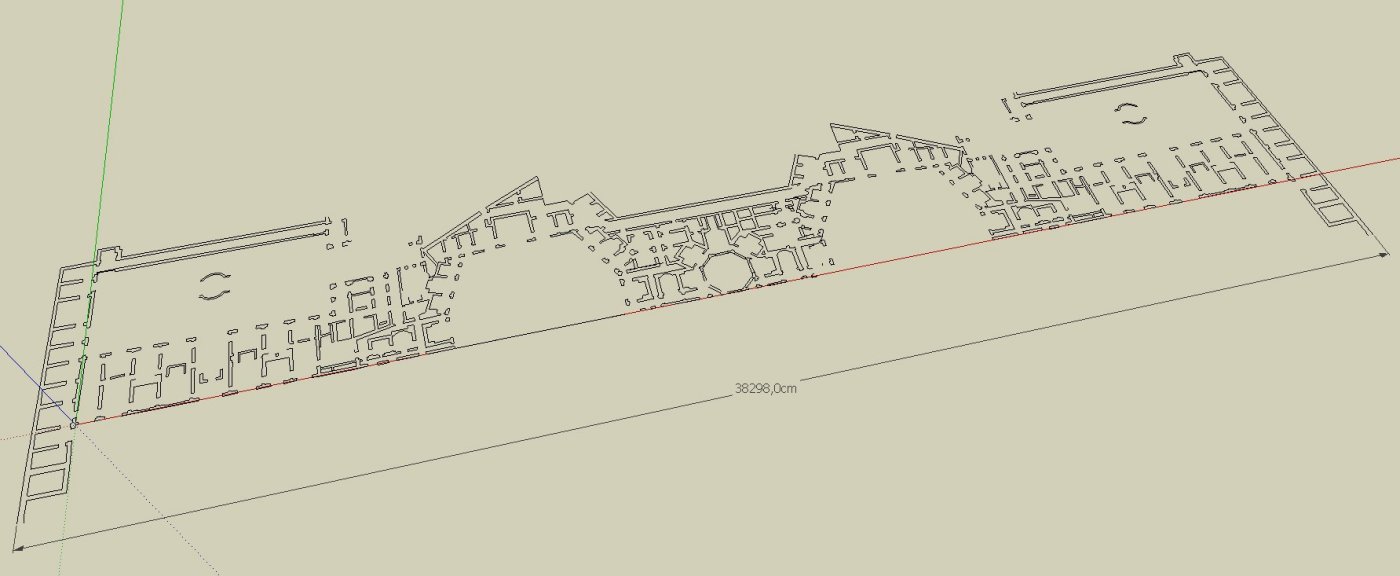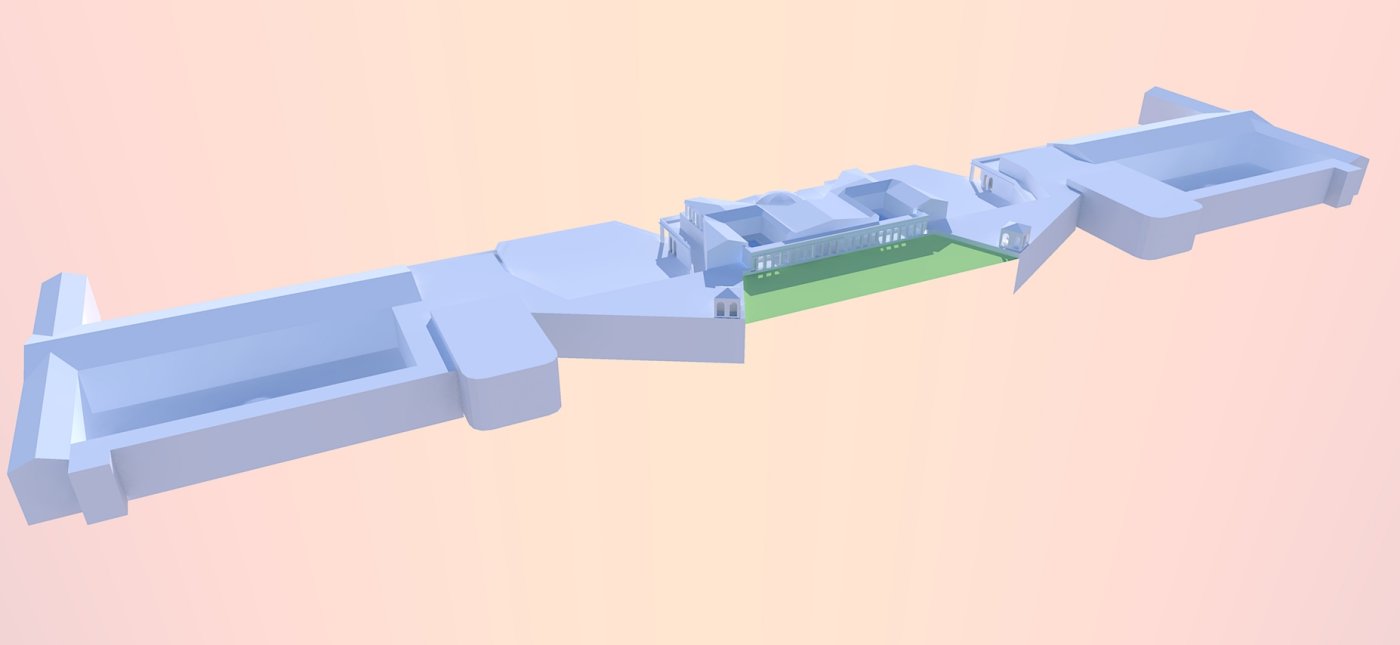Build Rome
-
Making similar geometry into instances of components is definitely a good idea (if you want to replace with lower poly versions for instance, you need to change only one). However unfortunately it won't lower the weight as the computer still needs to display the geometry.
There are two useful plugins however;
- TIG's Matrix Proximity Plugin - that can replace componets with simpler versions depending on the scenes (say when something is far from camera 1, it is very simple, when mid-distance from camera 2, mid-poly while more detailed for camera 3 that is near to it)
- and Fredo's Ghost Component Plugin that can easily and interactively replace components with "proxies".
Now these can help you when modelling but when interactively displaying it (like the RomeReborn in GE) or when rendering, they of course do not work (although Kerkythea can handle billions of poly's so that won't be that much of a problem there than in SU).
-
As a matter of fact it's pretty light, the file .skp is just 100k. seems that replicating components helps a lot. Here it goes ...
-
Sorry, I posted before reading your very helpful hints. I'll have to try all those ... and I suppose that in the end it will be a matter of trial and error to find the right solution ...
-
Hey, you said you used components for the columns! No, they are groups!
I have converted them into instances of components and also fixed a bunch of reversed faces. Interestingly, the file size is now bigger a bit but I guess only because it is a fairly simple model yet. Later it will yield to have those components.
-
Thanks a lot, Csaba. I have to go through the tutorials about groups and components again. Did you use some plugin to set the faces in the right direction?
Well, I am now getting to Nero's golden house. Some explanation needed, I suppose. Excavations have shown that Nero's atrium was about 24 m. longer than the base of Venus and Rome, and we have some good hints for the plan, even if the broadness of the lake is not sure, it might be a little narrower. We'll try to get our hands on some recent excavations for that. The location of the colossus is pretty sure, the axis of the Via Sacra is at an angle with the axis of the atrium, and of course the colossus had to be seen central to both axes.
I was intrigued by the fact that by extending the base of V&R the southern cell gets to be almost exactly in the center. I thought it could be an interesting hipotesis that Nero had a temple at the center, that it was left off center by the shortening, and that Hadrian, once removed the colossus, had restored simmetry by mirroring the temple. This would also explain the tipology of the twin temples, rather unusual. But the archaeologist (my wife, can't argue with her) decided that that was not OK for an atrium. So I settled for a pond.
There are some more speculations on the back side, excavations show a wedge that was meant to hide the difference in the two axes, but it's not sure if the front was in line with the front of V&R or further back ...

-
more images





-
I don't quite understand what happens with file size. I eliminated the heavy elements I had used for rendering, and file size when saved remained at about 6 Mb. I tried several things, in the end I exported to dxf and imported back, and it went down to 500 kb. Then I inverted a couple of faces and some colors, and it jumped back to 1 Mb. ?????
-
I still see a bunch of back faces. Here is a plugin which (when activated from the Plugins menu) you can "sweep through" your model and no matter if a face is inside a group/component, it will reverse back faces to front faces.
Otherwise it is getting nice shape, indeed. Have I already told you that I am an archaeologist myself? (And top of all, a Roman age one - although admittedly here, in the semi-barbarian Pannonia Inferior, we have more military architecture than anything else - especially not like those spectacular buildings in Rome itself although the World Heritage site of my city is Roman archaeology).
Anyway, about your file size issue. Once you import any components (like a "heavy" statue), it will still be kept in your model after you delete it from model space. The same with materials, unused styles and layers that do not contain anything.
All in the dialogs of these four, when you go to "In model" there is a fly-out menu on the right where you can "purge" unused items.
If you want to purge everything (all four together), you can also do it from Window > Model info > Statistics.
-
Thanks again, Csaba. I did as you said and, miracle! The size dropped to 300 k.
Yes, you told me you are an archaeologist. Our contact in Pannonia is Tamas Besetzky, with whom we are frequently in touch and who comes to Rome from time to time, suppose you know him. Well, if you do come to Rome sometime you now have a contact too. -

I'll make sure to remind you!

-
Hey, good start. Hope we can see it as it progresses.
One thing you might want to do is rescale the whole model to actual size. Believe me, it will avoid hassle later.
Its current 46 kilometres long which I think even the Romans would struggle building.

FYI. You can use the tape measure tool by measuring an edge in your model, and then typing in the length you want that edge and SketchUp will prompt you as to whether you wish the whole model scaled.
-
@adamb said:
Hey, good start. Hope we can see it as it progresses.
One thing you might want to do is rescale the whole model to actual size. Believe me, it will avoid hassle later.
Its current 46 kilometres long which I think even the Romans would struggle building.

FYI. You can use the tape measure tool by measuring an edge in your model, and then typing in the length you want that edge and SketchUp will prompt you as to whether you wish the whole model scaled.
Thanks, but as a matter of fact the models are in scale, only that it's centimeters ...
-
AdamB is right the man in the model is 171 meters .
Your model is probable scaled up 100x i think.Bep
-
You are right, these were the starting measures. Somewhere along the line I must have done something wrong, and the scale went askew ...

-
-
Ok, I started playing with the wing of the Domus Aurea on the Oppio hill ... I'll need to think it over, it's not easy ... The plan is known, more or less, there might be other bits and pieces.


-
Ok, this is what I got now. I took in account most of the archaeological evidence I found ...


-
Some comments (only regarding modelling)
- you still use groups for the columns instead of components (where you group at all - see below)
- Many of the columns are not even groups - anything that is repetitive should be made components
- What's worse, the above groups are not even copies of the same group definition (which would allow quick transformation into components) but made independently.
- The whole structure seems to be perfectly symmetrical. In this case you could make one half into a component and only model that and mirror the whole half onto the other side.
- I can still see some back faces but of course they can easily be fixed with Tomasz' plugin
- If you used components, Kerkythea could (I think) handle them as "instances" which would allow faster rendering, too. Not a big deal at the moment but with more complex geometry, the difference could already be noticeable
Nice model however.
-
Thanks, Csaba.
I've been using the plug ins for backfaces and mirroring that you gave me, and they are very useful. Of course I built only half and then mirrored. I am still trying to figure out exactly how components and groups work, I promise I'll take my time and go through the tutorials again ... -
Here is a more than an hour presentation about groups and components (SketchUp 3D BaseCamp video from 2008). I would suggest it not even to "newbies" but everyone.
YouTube - Hooray for Groups and Components
[flash=640,380:m3diuzzb]http://www.youtube.com/v/Au5VhCoLVE8?fs=1&hl=hu_HU[/flash:m3diuzzb]
Advertisement







